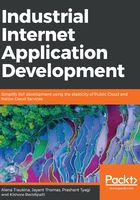
IIoT system architecture
IIoT system architecture, in its simplistic view, consists of three tiers (as the following diagram illustrates):
- Tier 1: Devices
- Tier 2: The Edge Gateway
- Tier 3: The cloud

Tier 1 of the IIoT architecture consists of networked components, typically sensors and actuators, from the IIoT equipment, which use protocols such as Modbus, Zigbee, or proprietary protocols, to connect to an Edge Gateway. Tier 2 includes sensor data aggregation systems called Edge Gateways that provide functionality, such as preprocessing of the data, securing connectivity to cloud, and using systems such as WebSockets, the event hub, and, even in some cases, edge analytics or fog computing. Tier 3 includes the cloud application built for IIoT using the microservices architecture, which is usually polyglot and inherently secure in nature using HTTPS/OAuth. Tier 3 also includes storage of sensor data using various database systems, such as time series databases or asset stores using backend data storage systems such as Cassandra or Postgres. In addition to data storage, we analyze the data using various analytics, predictive, or threshold-based, or regression-based, to get more insights on the IIoT equipment. In the following sections, we will explore these tiers in more detail so that you have a good idea of the underlying concepts.